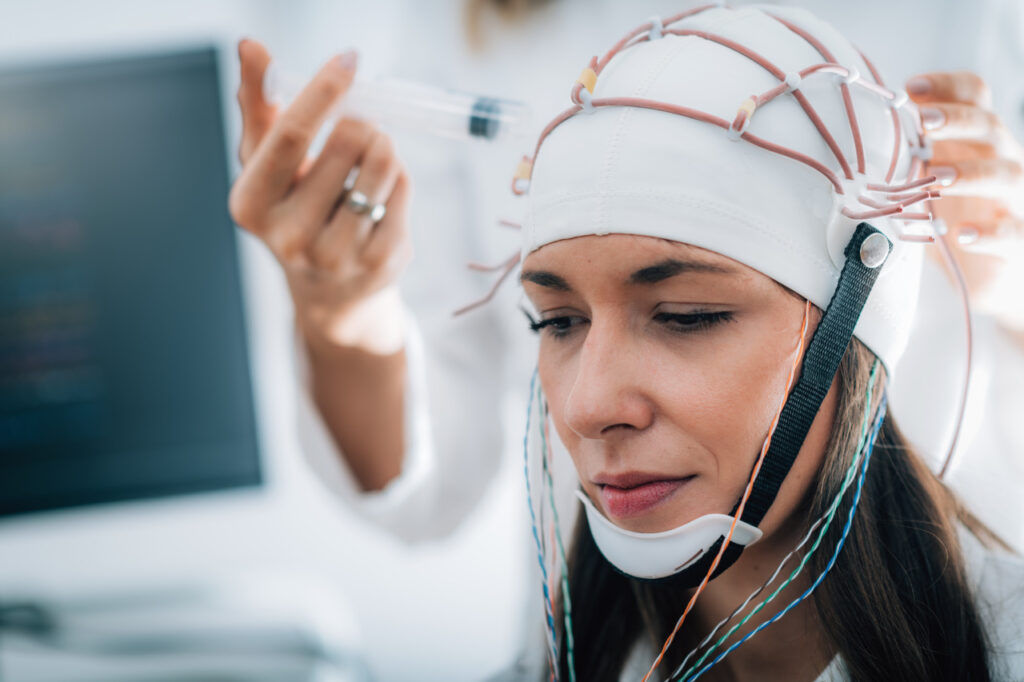Dieser Beitrag ist auch verfügbar auf:
Deutsch
Are touchscreens and voice control the pinnacle of technology?
Despite technological advances, input technologies that have been around since the 1970s still dominate the workplace today. Granted, touchscreens and voice control have grown in popularity over the past two decades. But the precision and ergonomics of computer mice and keyboards remain unmatched.
Imagine a company in any industry switching to touch screens and voice control. Management will likely decide to return to traditional input devices due to productivity issues very soon.
Controlling technology with our thoughts, on the other hand, seems to have almost unlimited potential. User interfaces that transform the user’s brain activity into text or graphics in seconds could revolutionize the way we work.
Science has long known that brain activity can be read as electric impulses. Surely, our technological progress should soon be advanced enough to use our brain waves to control computers, smartphones, and the like?
Neurons in our brain carry electrical signals
Brain cells communicate primarily through electrical signals. The human brain can generate enough electricity to power a light bulb. By simply attaching electrodes to the head, the electrical signals generated in the brain can be read and transmitted for evaluation and processing.
Humanity has dreamed of controlling technology with brain activity for many years
Research into the possibility of connecting the human brain to machines has been going on for more than 50 years. As early as 1969, researchers were able to measure the brain signals of laboratory monkeys using a deflection needle connected to brain electrodes.
In 1973, US scientist Jacques Vidal published the first scientific paper on the possibility of direct communication between the human brain and computers. However, it took until the year 2000 for the first complete definition of the requirements for an interface between the brain and computer to appear.
Mind-machine interfaces are already in use in the medical field
In the early 21st century, reading brain waves via electrodes gradually became more sophisticated – and was mainly used to control high-tech prostheses.
The first thought-controlled arm prosthesis was presented in Vienna in 2007. In 2017, researchers at Stanford University developed a solution that enabled paralyzed people to operate a communication system with virtual letter keys using a mind-machine interface. In 2020, experts at the University of Michigan developed a mechanical hand prosthesis that executes commands with zero delay.
Quelle: YouTube / MichiganEngineering
Science currently recognizes three methods of connecting the brain to electronic devices:
Invasive brain-computer interfaces
Invasive BCIs (brain-computer interfaces) are implanted in the brain by means of a neurosurgical procedure. This method provides the best signal quality. As the surgery is a risky and expensive procedure, the target groups for invasive BCI are mainly blind and paralyzed patients.
In addition to requiring a risky surgical intervention in the brain, this procedure has another disadvantage: the body reacts to the foreign objects implanted in the brain and forms scars around the electrodes, which leads to a deterioration of the signal quality.
Non-invasive brain-computer interfaces
This approach does not require surgical intervention in the brain. A non-invasive brain-computer interface typically uses technology similar to an electroencephalography (EEG).
This method measures voltage fluctuations in the brain. Much of the current in the brain can still be measured from the scalp. For this reason, a headgear with sewn-in electrodes is used. The disadvantage is that the signals transmitted in this way are susceptible to loss and interference. This makes it difficult to control the attached devices precisely.
Semi-invasive brain-computer interfaces
This is done using an electrocorticography (ECoG) procedure. Electrodes are placed on the surface of the brain to measure electrical activity in the cerebral cortex. The signal quality is significantly higher than with non-invasive BCIs, although it does not reach the level of invasive BCIs. However, the skull must also be opened, which is why semi-invasive BCIs are only utilized for medical reasons.
Why can’t we control our computers and smartphones using our thoughts yet?
A number of commercial BCIs are now available for everyday use – these include gadgets from Nextmind, Neurable, Synchron and BrainNet. So far, however, these devices have only been able to trigger specific functions, such as performing certain movements in video games or measuring certain types of brain activity. Their manufacturers have acknowledged that they are not yet ready to function as universal input devices for everyday use.
BCIs designed for controlling computers still lack precision for everyday use
According to experts, the biggest shortcoming of BCIs is currently their lackluster precision. “BCIs do work. But they do not work very well,” Dr. Fabien Lotte, Head of Research at the National Research Institute for Computer Science and Automation in Bordeaux-Sud-Ouest, is quoted as saying.
According to Lotte, current BCI technology executes commands as intended in 60 to 80 percent of all cases. If only very simple commands are required, such as moving a cursor from left to right, the success rate increases slightly – to 70 to 80 percent.
Computer mice, keyboards and touchscreens remain more reliable – for the time being
Such figures still lag far behind the reliability of traditional input devices. It is true that using invasive and semi-invasive BCIs could lead to better performance. However, they still require high-risk surgical procedures. In addition, experts agree that at present, brain-computer interfaces can only provide useful results with special user training.
Moreover, BCIs currently only collect a small amount of data. This is mostly because the electrodes are usually only activated when the user wishes to trigger an action. However, data from the resting phase of the brain could also be useful to better predict the behavior of the BCI user.
Despite all setbacks, there are big plans for the future
It will definitely be many years before we can replace our keyboards and touchscreens with electrode caps. But there are already big plans for the next step after that: none other than Elon Musk is planning to develop a BCI interface that can not only read out information, but also store new information in the brain.
The goal is to create a symbiosis between our brains and computers. Truly a vision of a bright future, don’t you think?







